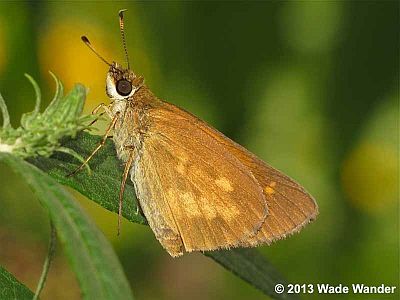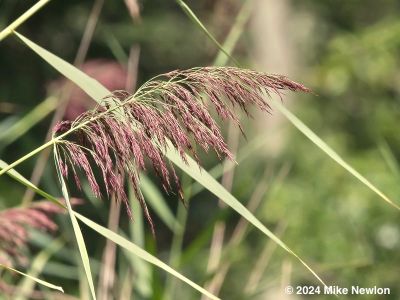New Jersey Butterfly Club
A chapter of the North American Butterfly Association (NABA)
Broad-winged Skipper
Poanes viator
Identification: Small—FW 0.8” (but large for a grass-skipper). Sexes similar below. Above: Male FW dark, with orange cell-end spot, orange "bracelet," and a large, roughly boot-shaped orange mark with the rounded toe pointing outward toward a separate small orange mark (as though it were kicking a stone). Female FW is similar to male's, but marks are smaller and whitish. Central orange patch on male HW has scalloped trailing edge. Female HW has smaller orange patch that mirrors the ventral pattern. Below: HW usually yellowish- or rusty-brown with a thick, paler central streak that is often crossed by a vague or irregular patch or short spotband. Markings may be bold or obscure, depending on wear and/or individual variation. Similar skippers: On the smaller Dion Skipper the HW below has 2 pale rays; the upper ray does not reach the trailing edge of the wing, and the rays are not crossed by other marks. Leonard's Skipper is also smaller and has a sharply defined chevron on HW below. Aaron's Skipper (generally confined to vicinity of coastal marshes) is duller olive-brown on the HW below with a narrower streak not crossed by other marks.
NJ Status and Distribution: Resident. Occurs throughout the state, but is much more common on the Coastal Plain, particularly in Cape May and Cumberland counties. In North Jersey is found more locally, usually as single individuals, in association with stands of Common Reed.

Habitat: Moist to wet stands of Common Reed. Will nectar in nearby meadows and gardens.
Flight Period: One brood from mid-June to late September, peaking in early to mid-July. Extreme dates: North Jersey 6/8—9/22; South Jersey 6/3—10/8.
Caterpillar Food Plants: Common Reed (Phragmites australis) and Wild Rice (Zizania aquatica); possibly Big Cordgrass (Spartina cynosuroides).
Overwintering Stage: Caterpillar.
Good Locations: DeKorte SP, Sandy Hook GNRA, Crosswicks Creek Park, Forsythe NWR, TNC Eldora Nature Preserve, Mannington Marsh, Supawna Meadows NWR, PSE&G Estuary Enhancement Area, Palmyra Cove Nature Park, Dix WMA.
Comments: Frequently perches vertically on reed stems. Often seen nectaring on Purple Loosestrife, which grows in wet habitats, often in association with Common Reed.




